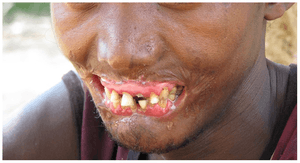Noma (disease)
Noma (also known as cancrum oris) is a rapidly progressive often gangrenous infection of the mouth and face.[2]
| Noma | |
|---|---|
| Other names | cancrum oris, fusospirochetal gangrene, necrotizing ulcerative stomatitis, stomatitis gangrenosa[1] |
 | |
| A man afflicted with noma | |
| Specialty | Gastroenterology |
Signs and symptoms
.jpg)
The mucous membranes of the mouth develop ulcers, and rapid, painful tissue degeneration ensues, which can degrade tissues of the bones in the face.[3]
Causes
Noma affects extremely impoverished and malnourished children in sub-Saharan countries and other tropical regions; while some bacterial organisms are often found in affected children, these same bacteria are widespread. The underlying causes for this disease are primarily poverty and malnutrition.[4][2]
Fusobacterium necrophorum and Prevotella intermedia are important bacterial pathogens in this disease process, interacting with one or more other bacterial organisms (such as Borrelia vincentii, Porphyromonas gingivalis, Tannerella forsythia, Treponema denticola, Staphylococcus aureus, and certain species of nonhemolytic Streptococcus).[5] Treatment of these organisms can help arrest the infection, but does not restore already-missing or disfigured tissue.
It is often reported as a sequela to acute necrotising ulcerative gingivitis. Predisposing factors include:[2][6][7]
- malnutrition (particularly Vitamin-A and Vitamin-B) or dehydration
- poor hygiene, particularly oral
- unsafe drinking water
- proximity to unkempt livestock
- recent illness
- an immunodeficiency disease, including AIDS
- measles
- smoking
Treatment
Known in antiquity to such physicians as Hippocrates and Galen, noma was once reported around the world, including Europe and the United States. With improvements in hygiene and nutrition, noma has disappeared from industrialized countries since the 20th century, except during World War II when it was endemic to Auschwitz and Belsen concentration camps.[8] The disease and treatments were studied by Berthold Epstein, a Czech physician and forced-labor prisoner who had recommended the study under Josef Mengele's direction.[8]
The progression of the disease can be halted with the use of antibiotics and improved nutrition; however, its physical effects are permanent and may require oral and maxillofacial surgery or reconstructive plastic surgery to repair. Reconstruction is usually very challenging and should be delayed until full recovery (usually about one year following initial intervention).[9]
Prognosis
The disease is associated with high morbidity and mortality[10] and affects mainly children in the poorest countries of Africa. Children in Asia and some countries of South America are also highly affected. Most children who get the disease are between the ages of two and six years old.[11] The WHO estimates that 500,000 people are affected, and that 140,000 new cases are reported each year.[12] The mortality rate is approximately 90 percent.[1]
Society and culture
Children and other noma survivors in Africa are helped by a few international charitable organizations, such as Facing Africa, a UK registered charity that helps affected Ethiopian, and Swiss charity Winds of Hope.[13] There is one dedicated noma hospital in Nigeria, the Noma Children Hospital Sokoto, staffed by resident and visiting medical teams. In other countries, such as Ethiopia, international charities work in collaboration with the local health care system to provide complex reconstructive surgery which can give back facial functions such as eating, speaking and smiling. Teams of volunteer medics coming from abroad are often needed to support the local capacity to address the most severe cases, which can be extremely challenging even for senior maxillofacial surgeons.[14] On 10 June 2010 the work of such volunteer surgeons was featured in a UK BBC Two documentary presented by Ben Fogle, Make Me a New Face: Hope for Africa's Hidden Children. Recently a case was reported from Nepal where the 19-year-old girl received free surgical treatment in Chitwan Medical College, Bharatpur; the team of surgeons was led by Dr. Sushil Subedi, Oral and Maxillofacial surgeon and the head of Department.[15][16]
See also
References
- Marck KW (April 2003). "A history of noma, the "Face of Poverty"". Plastic and Reconstructive Surgery. 111 (5): 1702–7. doi:10.1097/01.PRS.0000055445.84307.3C. PMID 12655218.
- Enwonwu CO, Falkler WA, Phillips RS (2006). "Noma (cancrum oris)". Lancet. 368 (9530): 147–56. doi:10.1016/S0140-6736(06)69004-1. PMID 16829299.
- "AllRefer Health - Noma (Cancrum Oris, Gangrenous Stomatitis)". Archived from the original on 2007-05-28. Retrieved 2007-07-12.
- Srour ML, Marck K, Baratti-Mayer D (February 2017). "Noma: Overview of a Neglected Disease and Human Rights Violation". The American Journal of Tropical Medicine and Hygiene. 96 (2): 268–274. doi:10.4269/ajtmh.16-0718. PMC 5303022. PMID 28093536.
- Neville, Brad. Oral and Maxillofacial Pathology (3rd ed.). Saunders Book Company. pp. 062008. 5.11.
- Auluck A, Pai KM (2005). "Noma: Life Cycle of a Devastating Sore - Case Report and Literature Review" (PDF). Journal of the Canadian Dental Association. 71 (10): 757–757c. PMID 16324228.
- Enwonwu CO (2006). "Noma--the ulcer of extreme poverty". The New England Journal of Medicine. 354 (3): 221–4. doi:10.1056/NEJMp058193. PMID 16421362.
- Lifton RJ (1986). The Nazi Doctors: Medical Killing and Psychological Genocide. Basic Books. p. 361. ISBN 978-0-465-04905-9.
- Neville, Brad. Oral and Maxillofacial Pathology, 3rd Ed. Saunders Book Company, 062008. 5.11.2
- Barmes DE, Enwonwu CO, Leclercq MH, Bourgeois D, Falkler WA (1997). "The need for action against oro-facial gangrene (noma)". Trop Med Int Health. 2 (12): 1111–1114. doi:10.1046/j.1365-3156.1997.d01-220.x. PMID 9438464.
- "The European Noma-Network". Retrieved 2007-07-12.
- Bourgeois DM, Leclercq MH (1999). "The World Health Organization initiative on noma". Oral Dis. 5 (2): 172–174. doi:10.1111/j.1601-0825.1999.tb00085.x. PMID 10522217.
- Fondation Winds of Hope
- Medical care Archived 2009-04-28 at the Wayback Machine at Project Harar
- "Make Me a New Face: Hope for Africa's Hidden Children". BBC. June 2010. Retrieved January 13, 2016.
- Fogle, Ben (July 6, 2010). "Ben's Documentary on Noma - BBC2". BenFogle.com. Archived from the original on April 11, 2018. Retrieved January 13, 2010.
Further reading
- Tonna JE, Lewin MR, Mensh B (December 2010). Franco-Paredes C (ed.). "A case and review of noma". PLOS Neglected Tropical Diseases. 4 (12): e869. doi:10.1371/journal.pntd.0000869. PMC 3006140. PMID 21200428.
- Boss K, Marck K (2006). The Surgical Treatment of Noma (in Dutch). Alphen aan den Rijn : Belvédère/Mediadact. ISBN 978-90-71736-31-5.